THUNDER BAY – A shortage of drivers is forcing Thunder Bay Transit to regularly cancel runs on numerous bus routes, an issue that’s expected to last for months as the city struggles to fill vacancies.
About one in six driver positions – roughly 20 out of 120 – is currently vacant, a mix of full-time and part-time positions, said transit manager Brad Loroff.
That’s caused the city’s transit agency to announce cancellations of runs, or parts of them, on various routes on several days in recent weeks.
While service disruptions aren’t unheard of, Loroff said they’ve been driven higher than he’s seen by the vacancies, a problem he said exists across the province.
“This is [relatively] new, certainly to this degree,” he said. “I don’t think we’re alone – when we talk to some of our other transit partners in Ontario, they’re going through the same thing.”
Loroff encouraged riders to check NextLift for real-time service updates. Thunder Bay Transit has also begun posting lists of disrupted routes on its Facebook page.
The staffing shortages are the worst he’s seen in his 32 years with Thunder Bay Transit, said Fred Caputo, president of the Amalgamated Transit Union (ATU) Local 966, which represents operators and technicians.
Working as a transit operator isn’t the appealing gig it once was, he said, reporting openings that used to draw hundreds of applicants now sometimes only receive a handful.
He believes safety and scheduling issues – especially for part-time drivers – are the two biggest challenges for recruitment and retention.
The challenges also come during a bump in retirements, he said, compounding the problem.
While he acknowledged many sectors are facing labour shortages, he believes the city could do more to resolve the roots of the problem.
Part-time drivers spend up to 13.5 hours on call without pay during on-call days, he said, and often don’t know their schedule for those days until the afternoon before.
He believes that’s contributing to high turnover rates for part-time drivers, particularly those with families, who he said struggle to reconcile unpredictable on-call hours with child care schedules.
“They’re not getting scheduled properly,” he said. “You don’t know what you’re doing all day… Who’s going to stay at a job that provides no real firm schedule?”
The union has pushed to receive schedules a week in advance, he said.
Job seekers are also aware it’s a demanding job, with drivers facing verbal abuse and sometimes physical assault in the role, and dealing with intoxicated riders, said Caputo.
“It’s just a mess, especially around city hall,” he said. “You’re not going to attract employees with that kind of situation going on… From a recruiting [perspective], that’s a big red flag for people.”
Loroff said the city is working with the ATU to address those issues.
“We are aware of some scheduling and safety related issues raised by ATU 966, and these issues are a part of ongoing discussions and problem-solving efforts with the union,” he said.
Transit is trying to avoid cutting service levels due to shortages, he said, instead hoping to minimize intermittent disruptions to scheduled routes as much as possible.
“With our ridership slowly recovering, we didn’t think it would be appropriate to do something like that, which is why we’ve attempted to maintain full service levels,” he said.
Ridership had risen to around 63 per cent of pre-COVID levels by the end of May, he reported, a quicker recovery than anticipated.
The city began the year around 37 per cent of 2019 levels, when there were around 4.2 million trips throughout the year.
While Loroff said he hoped to resolve the issue of consistent service disruptions by the fall, he acknowledged it’s also possible recruitment challenges will prove longer-lasting.
He said the city is constantly recruiting and has made some recent hires who are now in training, but that process can take up to three months.
